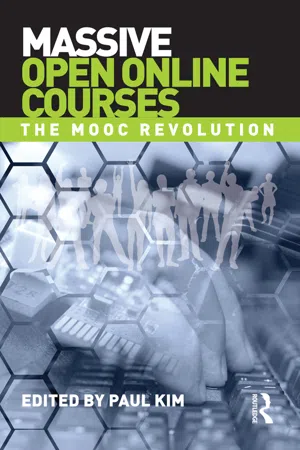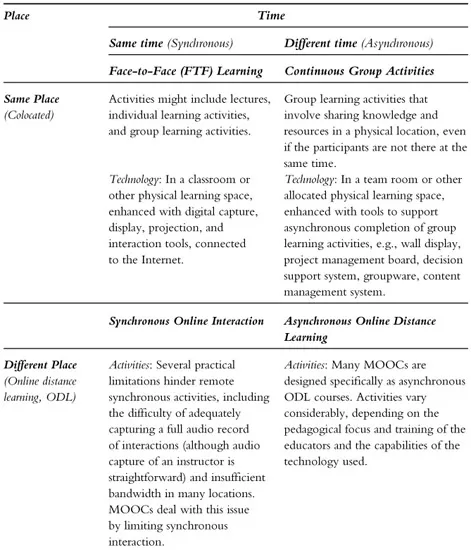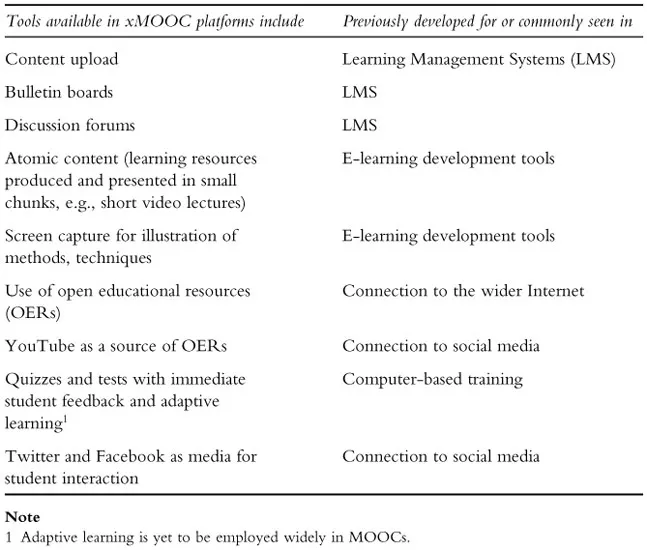
- 166 pages
- English
- ePUB (mobile friendly)
- Available on iOS & Android
About This Book
Are MOOCs a catalyst for reimagining education, a sign of the increased corporatization of the education sector, or merely a well-publicized but passing trend? Massive Open Online Courses shares insights from multiple stakeholders on what MOOCs are now and could eventually become, providing those in higher education as well as K-12, military, government, and corporate training with an authoritative source on a wide range of key issues surrounding MOOCs.
MOOCs, or Massive Open Online Courses, are a disruptive technology currently forcing a serious reconceptualization of accreditation, assessment, motivation and retention, technology-based instruction, and the overall student experience. In this timely volume, Paul Kim brings together experts from higher education, business, law, learning analytics and other relevant areas to provide an evenhanded, research-based positioning of MOOCs within the existing educational technology landscape and a base for understanding whether they could reshape the future of education.
Frequently asked questions
Information
1
The Anatomy of MOOCs
Introduction

MOOC: Breaking Down the Acronym

- M for Massive refers to the capacity of MOOCs to accommodate very large numbers of learners, well beyond the numbers that can be accommodated in classrooms or that had participated in online courses prior to the first MOOC. There is no specific number associated with “massive.” When the term MOOC was first coined, it referred to a course of 2,200 students (Cormier, 2008; Downes, 2009). Several MOOCs have since attracted more than 150,000 registrations (Jordan, 2014).
The capacity of MOOCs to be massive reflects developments in information and communications technology (ICT) and the pedagogy of online and distance learning, as illustrated in Figure 1.3. Relevant ICT advances1 include:- – infrastructure and software services to store, index and remotely access very large amounts of digital content (e.g., YouTube, Google Books, digital libraries, cloud computing archives);
- – secure registration and identification of very large numbers of users (needed for social media); and
- – robust, reliable, and secure software and services for simultaneous access by very large numbers of users to the same Web pages and media (as occurs with social media).
New technical issues associated with the large scale of MOOCs are being resolved as they arise (Hunt & Mares, 2013; Martin & Gil, 2013), so MOOC technology appears to be scalable to meet demand. The technical capacity for massive enrolments, combined with an openness to acceptance of all learners who register for a MOOC (see O for Open, below) also has significant implications for MOOC pedagogy, which we discuss in a separate section. FIGURE 1.3 Some developments that enable MOOCs to be massive
FIGURE 1.3 Some developments that enable MOOCs to be massive - O for Open has several different interpretations in the MOOC arena. The most common are outlined in Table 1.1.
Two other types of openness appear to be emerging along with MOOCs, according to a White Paper prepared by the UK Centre for Educational Technology, Interoperability and Standards (CETIS). These are open assessment, in which the learner chooses whether or not to have their work assessed, replacing the existing institutional monopoly on formal assessment with “on-demand accreditation,” and open curriculum, in which the learner creates their own curriculum by selecting courses from those available (Yuan & Powell, 2013). - O for Online defines MOOCs as online courses, regardless of their relationship to classroom-based courses and activities. The first course to be described as a MOOC, Connectivism and Connective Knowledge (CCK08), was an online open learning course offered (at a distance) in 2008 by George Siemens and Stephen Downes at the University of Manitoba in Canada. Of the 2,200 participants, only 24 were enrolled for university credit (Downes, 2009). Many MOOCs still have a classroom analog. Some, but not all, of these courses are offered simultaneously to both enrolled and non-enrolled participants.
Whether the MOOC is held simultaneously with its classroom analog or not, most online participation is asynchronous: learners choose their own time to access content and follow course activities rather than attend online, “live” lectures and meetings. The places and times at which segments of a MOOC are offered affect the types of learning activity and technology that can be used. Table 1.2 illustrates a range of possibilities, with observations from current MOOC practice.
Because they are online and open, MOOCs can be used as open educational resources (OERs) for classroom-based courses. A MOOC can be embedded in a traditional classroom-based course to transform it into a blended learning course; part of the learning takes place online, in the MOOC, and part face-to-face in the classroom. A specific adaptation of this model is a “flipped classroom” (Baker, 2000; Fisher, 2012; Forsey, Low, & Glance, 2013), in which students study by MOOC at home and classroom sessions are used to deal with issues and difficulties that arise from the “homework.” Regardless of the approach used, the MOOC itself remains online.TABLE 1.1 Some definitions of “open” in the MOOCs arena, and their use
 TABLE 1.2 Possible variations in learning activities and technologies, by place and time of MOOC participation
TABLE 1.2 Possible variations in learning activities and technologies, by place and time of MOOC participation

- C for Course reminds us that the foundation of MOOCs, whether considered in terms of the merits of different providers and platforms, strategies, or business models, is still a course, i.e., a systematic sequence of learning activities. Courses need to be designed, developed, run, evaluated, and revised, and the effort involved in these tasks is considerable—particularly when they are open to massive numbers of learners of diverse abilities and backgrounds, and offered online. A distinction is made between cMOOCs (connectivist MOOCs3), and MOOCs that adopt a different pedagogy, particularly the content delivery style synonymous with courses offered by large aggregators such as Coursera and edX, known as “xMOOCs” (Siemens, 2012). Mounting a MOOC can involve substantial cost and a large and highly skilled team (Edinburgh University MOOC Teams, 2013; Head, 2013; Parr, 2013).
The MOOC Platform
- identity access management (IAM) or seamless interface to institutional IAM systems, for management of MOOC access;
- a content management system or a set of services that identify and manage or point to learning resources in different locations and different formats;
- a quiz generator or seamless interface to a set of quiz and learning activity generators;
- a bulletin board service, blog, or seamless interface to an external blogging service;
- a discussion forum or seamless interface to an environment that permits discussion or questions and answers;
- a wiki or seamless interface to an external wiki (less common than bulletin boards and forums);
- services that provide links to the World Wide Web and the wider Internet;
- a course development environment or a seamless interface to such an environment;
- the teacher interface to the course;
- the learner interface to the course;
- services that identify and deliver learning resources and utilities to the learner when required;
- administrative tools for reporting and enabling “learning analytics” (detailed analysis of data concerning user access and progress while using the platform).

Table of contents
- Cover
- Title
- Copyright
- CONTENTS
- Introduction
- 1 The Anatomy of MOOCs
- 2 MOOC Pedagogy
- 3 To MOOC or Not to MOOC? University Decision-Making and Agile Governance for Educational Innovation
- 4 Enter the Anti-MOOCs: The Reinvention of Online Learning as a Form of Social Commentary
- 5 Developing a Sustainable MOOC Business Model
- 6 The Subject Matters: MOOCs and Relevancy
- 7 NovoEd, a Social Learning Environment
- 8 MOOCs, Copyright, and the Many Meanings of “Open”
- 9 Educating Educators: Designing MOOCs for Professional Learning
- Contributing Authors
- Index